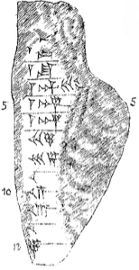A Fragment of a Synchronistic King List (VAT 11931)
A small fragment of a clay tablet (VAT 11931) discovered at Ashur by the Germans at the beginning of the twentieth century may be inscribed with a copy of a Synchronistic King List [https://www.livius.org/sources/content/anet/272-synchronic-king-list/]. The names of some of the rulers from the period of the Uncertain Dynasties [/ribo/babylon6/index.html] (978-626 BC) are preserved in lines 1'-6'.

What little survives on this sliver of clay may tentatively be read as follows:
| Lacuna | ||
| 1') | [N (years)] Aš[šur-nādin-šumi] | [...] |
| 2') | [N (years)] Šū[zubu (Nergal-ušēzib)] | [...] |
| 3') | [N (years)] Šū[zubu (Mušēzib-Marduk)] | [...] |
| 4') | [N (years)] Sennach[erib] | [...] |
| 5') | [N (years)] Esar[haddon] | [...] |
| 6') | [N (years)] Ashur[banipal] | [...] |
| 7') | 27 (years) [Erība-Adad (I)] | [...] |
| 8') | 35 (years) [Aššur-uballiṭ (I)] | [...] |
| 9') | 10 (years) [Enlil-nārārī] | [...] |
| 10') | 12 (years) [Arik-dīn-ili] | [...] |
| 11') | [N+]13 (years) [Adad-nārārī (I)] | [...] |
| 12') | [N+]10 (years) [Shalmaneser (I)] | [...] |
| 13') | [N]+7 (years) [Tukultī-Ninurta (I)] | [...] |
| Lacuna |
Because the arrangement of the material presented above makes little chronological sense -- with the eighth- and seventh-century rulers appearing before their fourteenth- and thirteenth-century predecessors -- it has been tentatively proposed by A. Kirk Grayson that: (1) the contents were (originally) from a large four-column clay tablet inscribed with a Synchronistic King List [https://www.livius.org/sources/content/anet/272-synchronic-king-list/]; (2) the kings listed in lines 7'-13' may have come from the beginnings of lines from col. iii (the right column of the reverse face); and (3) the rulers listed in lines 1'-6' may have come from the ends of lines from col. iv (the left column of the reverse face) and had to be squeezed into a small amount of space. Thus, Grayson's reworked hypothetical and problematic translation reads as follows:
| Lacuna | ||
| iii 1') | 27 (years) [Erība-Adad (I)] | [...] |
| iii 2') | 35 (years) [Aššur-uballiṭ (I)] | [...] |
| iii 3') | 10 (years) [Enlil-nārārī] | [...] |
| iii 4') | 12 (years) [Arik-dīn-ili] | [...] |
| iii 5') | [N+]13 (years) [Adad-nārārī (I)] | [...] |
| iii 6') | [N+]10 (years) [Shalmaneser (I)] | [...] |
| iii 7') | [N]+7 (years) [Tukultī-Ninurta (I)] | [...] |
| Lacuna | ||
| iv 1') | [...] | [N (years)] Aš[šur-nādin-šumi] |
| iv 2') | [...] | [N (years)] Šū[zubu (Nergal-ušēzib)] |
| iv 3') | [...] | [N (years)] Šū[zubu (Mušēzib-Marduk)] |
| iv 4') | [...] | [N (years)] Sennach[erib] |
| iv 5') | [...] | [N (years)] Esar[haddon] |
| iv 6') | [...] | [N (years)] Ashur[banipal] |
| Lacuna |
Selected Bibliography
Grayson, A.K., 'Königslisten und Chroniken. B. Akkadisch,' in: D.O. Edzard (ed.), Reallexikon der Assyriologie und Vorderasiatischen Archäologie 6/1–2, Berlin/New York: de Gruyter, 1980, pp. 121–122 §3.13.
Schroeder, O., Keilschrifttexte aus Assur verschiedenen Inhalts (= Wissenschaftliche Veröffentlichungen der Deutschen Orient-Gesellschaft 35), Leipzig: Hinrichs, 1920, no. 9.
Jamie Novotny
Jamie Novotny, 'A Fragment of a Synchronistic King List (VAT 11931)', The Royal Inscriptions of Babylonia online (RIBo) Project, The RIBo Project, a sub-project of MOCCI, 2024 [http://oracc.museum.upenn.edu/ribo/KingLists/FragmentVAT11931/]